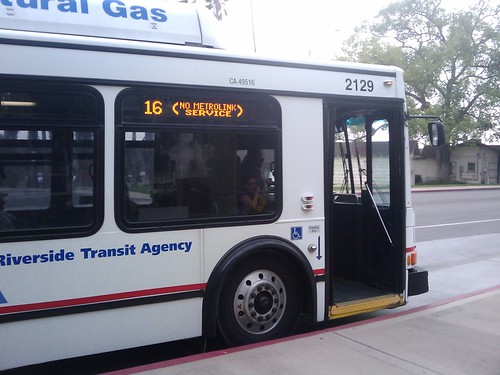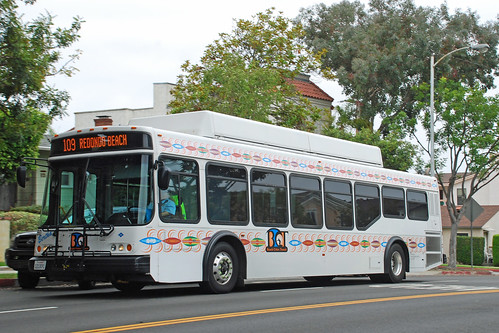Wednesday, September 29, 2010
Fiscal Surplus means MORE PARKING!
And, of course, "city services" means "free parking and roads". Of the $3.5m in surplus cash, City leaders spent $900,000 on the Public Works budget, which went into road maintenance and parking at the Orange Terrace Community Centre; and $600,000 on parks, which went into parking at Andulka Park (my local park, served by routes 22, 51 and 53). That's $1.5m, or 42% of the fiscal surplus, that went into car-related spending. This doesn't count the $1m that went in to the police department budget, and a goodly share of police resources in North America are spent either on traffic enforcement or collision cleanup and investigation.
As always, I see City leaders who seem to get it... and then do something spectacularly wrong.
Sunday, September 19, 2010
This Week in Transit, 9/19
If you find this feature useful, please don't hesitate to subscribe to either of these calendars.
Thursday, September 16, 2010
HSRA Meeting in LA
The "open house" portion of the meeting begins at 16:30 and ends at 21:00, with presentations between 17:30 and 19:30. For those who don't want to make the pilgrimage to Los Angeles, online streaming of the presentations will be available at http://bit.ly/CAHighSpeedRail. For more information, see Metro's web invitation.
Wednesday, September 15, 2010
Park[ing] Day LA this Friday
I'm going to start by visiting the Streetsblog LA space at 11555 National Blvd. near Santa Monica, then go hit up the UCLA space in Westwood Village (1130 Westwood Blvd). After that, I plan on heading to Hollywood and winding my way down through the various spaces along the Metro Red Line corridor, and then heading home. I strongly encourage you all to join me!
You can find more information, as well as a map of planned Park[ing] spaces, at http://parkingdayla.com.
Tuesday, September 14, 2010
Local Preference Policies
This is a bus.
This is also a bus. They're both partial-low-floor 40-foot buses with front and rear doors and bicycle racks. For all I know, they are equipped with the same fareboxes. So what's the difference between them, besides the agencies and routes they serve?
The one on the bottom was built in Alabama, with parts largely made in Hungary. The one on the top was built in Rubidoux, just outside of Riverside, with mostly locally-produced parts.
Most federal grants have what are known as "Buy America" conditions, which require things purchased with the grant money to be made in America. The idea is to spend our money on creating jobs in our country, sensibly enough.
If the idea works on a national scale, why then shouldn't we implement it on a local scale as well? The LA Times today has an article on "local preference policies"- language in city and agency purchasing policies that give local businesses an edge in getting jobs and contracts- the proposed bonus to LA businesses in LA is 8%.
So, what's the difference between the two buses at the top of this post? One of them creates jobs and tax revenue in Riverside and Riverside County, allowing it to provide more service to more people in a more prosperous local economy. Isn't that something we should all hope for?
San Bernardino County Wins
Riverside County also gained some operators in Google Transit yesterday- the Beaumont-operated routes of the Pass Transit system (2, 3, 4, 7, 8, 9 and 10) and the Palo Verde Valley Transit Authority in Blythe. Only one transit agency in the county remains un-Googled, but it's a major one: Sunline Transit in the greater Palm Springs area. Their web site lists Google Transit as "coming soon", but it has for several months.
Thursday, September 9, 2010
Victory for LGBT Rights in... Riverside?
Wednesday, September 8, 2010
"Saving the Planet" is Selfish
That said, there are many forms of life that are not vulnerable, and most natural systems will find a new equilibrium during the course of geologic time. Cockroaches, for example, will probably not experience a massive die-off, nor will ants, no matter what we humans do to the planet. Even a full-fledged nuclear winter is not, over the long term, going to bother the planet we live on.
Let us be clear. When we say that we want to save "the environment" or "the planet", we are being extremely selfish as a species. What we want to save is not some generic concept of planet Earth, which has survived untold devastation in the fullness of her life, nor even the planet's ability to support life, which it will go on doing no matter what we do to her. What we are saving is the planet's ability to support us, humanity. We are trying to save the planet's ability to support agriculture, commercial fishing and the like- to support, in essence, human civilization. Make no mistake about it- in a post-global warming world, life will carry on. I even think humanity will carry on, just because we are so very adaptable and there are so very many of us. What will falter, causing untold suffering, sickness and death, is the global civilization that we have built over the past several hundred years, and the advantages that it confers- communications, transportation, medicine, agriculture, leisure.
It's time the environmental movement stopped asking others to Save the Whales, to Save the Delta Smelt, to even Save the Planet, and time we started being honest about what we want to do- and that is to Save the Humans.
Transit Resources
Tuesday, September 7, 2010
Network Legibility in Riverside
Compare these routings to San Francisco Muni's policy of associating a route with a given street, and naming the route accordingly (N-Judah, 14-Mission, F-Market & Wharves, etc.). Every stop, headsign and route map there displays the name of the route, making it relatively simple to determine the principal service area of that route with nothing more than a glance. If you want to head up Mission, it's as simple as grabbing the bus that says "Mission". Muni is a legible system. RTA is not.
RTA has proposed doing a lot of service upgrades, schedule re-structuring and re-routing in order to get the system ready for the Magnolia Avenue Rapid line (which is still a few years off). One thing they want to do is get a core group of routes under 40 minute headways, and schedule them in such a way that they make timed connections to the aforementioned Rapid line when it shows up. This is an admirable goal, to be sure, but if significant improvements in the legibility of the system aren't made, new riders will be put off of the system simply because they don't know where the buses go. (I've seen this in action before- some UCR students heading up Canyon Crest from campus will actually refuse to ride the "white bus", the 16, and will allow it to pass them up in order to wait for the 51 Crest Cruiser "trolley" even though the 16 would work just as well.) This probably starts with streamlining routes, and then coming up with a system to simply indicate where each route runs.
Saturday, September 4, 2010
Emergency Rider Alert
To anyone riding routes 1, 16 or 25 and trying to get to the UCR/University Village area, these routes are currently detoured east of Chicago for road work. Call RTA at (800) 800-7821 for details and alternate stop locations.
Friday, September 3, 2010
Mobile Money Pits
Thursday, September 2, 2010
Speaking Gig
Seeking Contributors
Also, I'm thinking about scheduling a bloggy meetup at my local watering hole. Comment if you'd come.
Wednesday, September 1, 2010
New Omni Bus Book Out
Also available, by the way, is the new RTA Ride Guide.



